This month, we bring you some exciting developments and updates from the world of search, including new studies, industry developments and the effect of the March 2025 Core Update.
Firstly, Google officially concluded the rollout of the March 2025 Core Update on the 27th. As with previous updates, this is designed to improve the relevance and usefulness of search results, ensuring a better experience for users, promoting more types of content, e.g. video and social in the results as well as rewarding better web pages.
Additionally, as Google is testing AI Mode, there is a study exploring how Google’s AI Mode reshapes search results, highlighting new opportunities for visibility and the need for SEO adaptation across various query types and platforms.
There is also more concern about social search. Gen Z is moving away from traditional Google search to social media platforms like TikTok and Instagram, reshaping the search landscape with more visual and community-driven content.
Together, there are studies about developing LLMS.txt and geotagging photos for Google Business Profiles. We’ll explore these updates in more detail in the article below.
Allow our traffic light system to guide you to the articles that need your attention, so watch out for Red light updates as they’re major changes that will need you to take action, whereas amber updates may make you think and are definitely worth knowing, but aren’t urgent. And finally, green light updates, which are great for your SEO and site knowledge, but are less significant than others.
Keen to know more about any of these changes and what they mean for your SEO? Get in touch or visit our SEO agency page to find out how we can help.
- Google March 2025 Core Update finished rolling out
- How did this update affect SERP volatility?
- What was the impact of the update compared to the December 2024 core update?
- How geotagging photos affects Google Business Profile rank: Study
- Meet LLMs.txt, a proposed standard for AI website content crawling
- Google’s AI Mode: Here’s what matters for SEOs and marketers
- Social search is Gen Z’s Google: Are you visible where it matters?
- Google expands AI Overviews to more EU regions
- Google: If searchers don't use your page in search it may be removed
Google’s March 2025 Core Update was completed after a 14-day rollout, which began on the 13th of March and ended on the 27th of March. This update was the first recorded Google algorithm update of 2025, and it affected all regions and languages globally.
Google indicated this was a broad core update designed to surface more satisfying content for searchers. While Google noted that further improvements would be made throughout the year, they also stated that some sites might not fully recover from the changes.
How did this update affect SERP volatility?
The core update caused some volatility in search rankings, with certain sites experiencing significant drops or gains in visibility. However, it didn’t appear as widespread as previous updates.
Tracking tools showed some early signs of volatility starting around the 16th of March, and by the 26th of March, there was another wave of fluctuations.
Google also clarified that volatility observed before the update was unrelated to the March rollout and that periodic algorithm updates could occur without further announcements.
What was the impact of the update compared to the December 2024 core update?
Analysis of data from third-party tracking tools revealed some interesting comparisons between the March 2025 core update and the previous update from December 2024.
Semrush indicated that the volatility of the March 2025 core update was similar to that of the December update. Additionally, data from Similarweb showed that the average position remained relatively unchanged between the two updates.
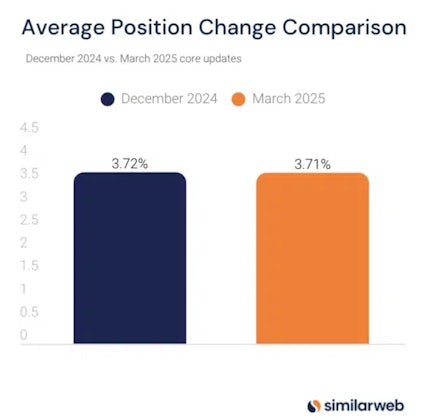
Further data from Similarweb indicated that the March core update displayed slightly lower fluctuations in the top three positions but increased volatility in the top five.
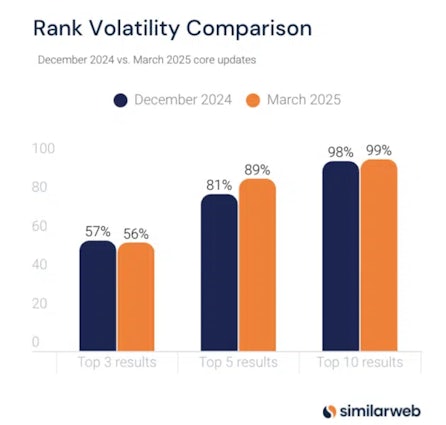
In addition to the recent expansion of AI Overviews for more EU countries, research from BrightEdge suggested that Google AI Overviews have expanded exponentially in three sectors following the March 2025 core update. The entertainment, restaurant and travel sectors saw a high percentage increase between the 13th and 27th of March:
- 528% for entertainment queries
- 387% for restaurant queries
- 381% for travel queries
Explore our comprehensive guide to read more about all the Google algorithm updates to date.
A 10-week study was conducted to assess whether geotagging images – adding location coordinates to photo EXIF metadata – affects the ranking of Google Business Profiles (GBPs) in local search results. The primary aim was to test the long-standing SEO debate on whether geotagging can influence visibility, especially in “near me” and “[service] + [city]” search queries.
The research involved 27 lawn care business clients, with all other SEO activities paused. Twice a week, images with embedded coordinates that targeted two towns in the company’s service area were uploaded to their GBPs. Prior to this, a clean baseline was established by uploading photographs without EXIF data for a five-week control period. [lawn care near me], [lawn care town A] and [lawn care town B] were among the keywords that were tracked.
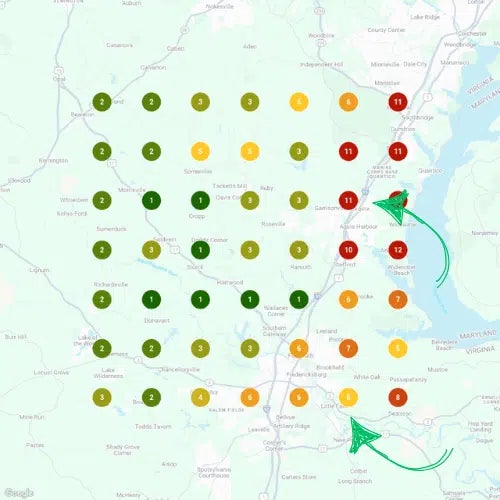
The results showed mixed outcomes:
- “Near me” queries in the specific geotagged towns experienced a statistically significant increase in rank. However, this improvement was not seen at the business’s actual location (its pin on the map) nor in the broader service area.
- “[Service] + [City]” queries experienced a drop in rankings in both the geotagged towns and the broader service area. This suggested that geotagging could harm visibility for more specific geographic search terms.
- Additional analysis across ranking metrics like Center of Address (CoA), Average Total Rank Position (ATRP), and Share of Local Voice (SoLV) confirmed the limited or negative impact of geotagging. Only one of the seven metrics, “near me” queries in the targeted towns, showed improvement; four saw a noticeable drop, and the remaining six showed no apparent shift.
The study also emphasised potential drawbacks to widespread geotagging. Attempting to geotag for every service area could clutter a GBP with low-quality, repetitive images, harming the profile’s visual appeal without guaranteed ranking gains. Additionally, the strategy overlooks the decline in performance for “[service] + [city]” queries, creating a trade-off that’s unlikely to be worth the effort.
In conclusion, while geotagging might slightly benefit “near me” rankings in targeted zones, it doesn’t justify the negative impacts elsewhere. The study’s authors opted against using this tactic for clients, choosing instead to focus on proven, impactful local SEO strategies.
The proposed LLMs.txt standard, introduced by technologist Jeremy Howard, is an emerging protocol to improve how websites interact with large language models (LLMs). Similar in concept to robots.txt and XML sitemaps, LLMs.txt provides clear instructions on how AI systems can access, interpret, and utilise website content.
Unlike robots.txt, which restricts or allows search engine crawlers, LLMs.txt doesn’t block content but offers a flattened, AI-friendly version of a website’s content. This structured markdown file helps LLMs read and process key site information without the complexity of JavaScript, ads, and navigation elements. In essence, it allows site owners to curate what and how content is shared with AI tools, potentially improving indexing, attribution, and user experience in AI-generated responses.
One significant benefit is its simplicity: all of a website’s content can be shown in markdown or plain text, making it easier for LLMs to analyse and comprehend. This can be helpful for technical websites, manuals, or instructional materials. The protocol is adaptable; files can be divided into sections or categories based on the user’s needs and contain links, summaries, or full-text material.
Versions of LLMs.txt are already being used by businesses such as Hugging Face, Zapier, and Anthropic. Tools like Markdowner, Appify, and WordPress plugins have been developed to help producers create these files. There are still issues because not all LLMs will follow the protocol, and there is a chance for misuse, such as competitive data scraping or keyword stuffing.
Critics argue that LLMs are not fundamentally different from traditional web crawlers and question whether another protocol is necessary when tools like robots.txt and sitemaps already exist. Others, however, see LLMs.txt as a promising evolution, offering more precision and transparency in how AI systems interact with online content.
Whether it becomes a widely adopted standard remains to be seen. However, as AI continues to shape digital content distribution, having a defined strategy could become essential for content visibility and control.
Google’s AI Mode: Here’s what matters for SEOs and marketers

Link Google’s AI Mode, launched via Search Labs, is reshaping how search results are displayed by integrating AI-generated summaries directly into the Search Engine Results Pages (SERPs). After extensive testing across various search intents (transactional, navigational, commercial, and informational), clear patterns have emerged that SEOs and marketers must pay attention to.
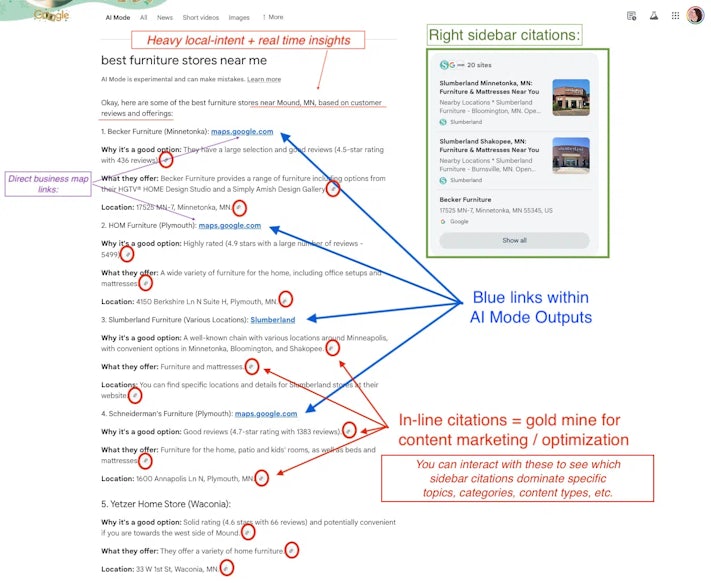
AI Mode has results that differ greatly depending on the inquiry. For instance, a search query such as [cheap flights] produced answers ranging from 370 to 449 words and included up to 39 citations in a sidebar on the right. The longest AI-generated content, often exceeding 500 words, is produced in response to commercial and informational requests; these queries are more like blog entries than straightforward responses. For example, [Laptop brands] contained 56 citations and 576 words.
Interestingly, there’s a shift in visibility for queries where AI summaries are shown; page 2 results often appear as citations in the AI output, giving previously hidden content a new spotlight.
A key change is the increased localisation of content. Even queries with no clear geographic relevance, like [subscribe newsletter] or [online courses], include localised context and tailored recommendations. Google is over-indexing on local signals, likely to reinforce its relevance against competitors.
Thumbnails are crucial for visibility. About 85% of citations include an 82×82 px image, typically pulled from optimised content headers. URLs without visuals are at a disadvantage, so it’s essential to add clear, keyword-relevant images to your pages. Read our guide about SERP Features at SERP Features: The Complete Guide.
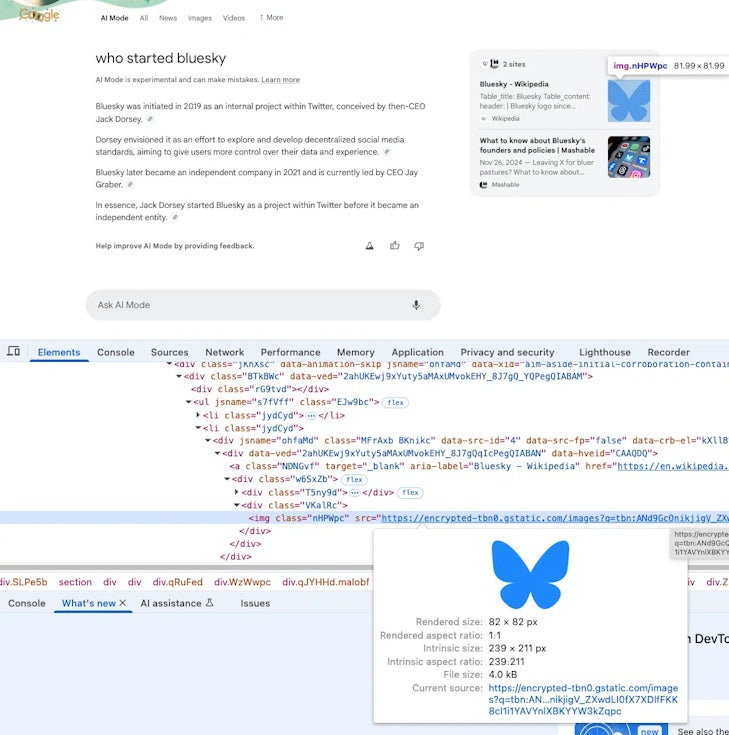
Citation mechanics show another evolution: AI Mode links often bring users to the exact cited passage, much like featured snippets. Mobile AI Mode displays roughly 50% fewer citations than desktop, suggesting optimisation should be screen-specific. Content authority still matters, with older posts from figures like Neil Patel ranking prominently.
However, the system is not perfect. Bugs and quirks remain, such as irrelevant citations or broken outputs. Google is experimenting with AI Mode’s infrastructure and interface, making now an ideal time for SEOs to observe and adapt.
Search behaviour is evolving rapidly, with Gen Z driving a significant shift from Google toward platforms like TikTok, Instagram, YouTube, Reddit, and Discord. This generation prefers fast, visual, and authentic content over traditional, text-heavy Google results filled with ads. A study revealed that Google usage among Gen Z is 25% lower than Gen X, while 46% of Gen Z prefer social platforms for search.
Social platforms have transformed into search destinations, reshaping the traditional funnel. Users no longer move linearly from awareness to purchase. Instead, a TikTok video sparks interest, an Instagram post deepens discovery, and a Reddit thread builds trust, all before a Google search happens, if at all.
Three key behaviours power this new model:
- Visual-first search: Gen Z expects quick, engaging formats like short videos and carousels over long blog posts or blue links.
- Trust in authenticity: They prefer peer recommendations and real experiences over polished brand content or paid search ads.
- Algorithm-led discovery: Platforms like TikTok and Instagram surface content before users even search, pushing discovery earlier in the journey.
Community-driven search is also rising. Platforms like Reddit and Discord are trusted hubs for real conversations and lived experiences. Gen Z actively adds “Reddit” to Google searches to find authentic content, bypassing SEO-optimised pages.
Traditional SEO doesn’t work here. To succeed, brands must embed themselves naturally in communities, offer valuable, non-promotional content, and engage through real people, not just ads.
Google expanded the availability of its AI Overviews feature to more European regions after testing earlier in March.
This announcement marks a significant expansion as AI Overviews are now officially live in countries including Germany, Belgium, Ireland, Italy, Austria, Poland, Portugal, Spain, and Switzerland:
- Germany (German and English)
- Belgium (English only at launch)
- Ireland (English)
- Italy (Italian and English)
- Austria (German and English)
- Poland (Polish and English)
- Portugal (Portuguese and English)
- Spain (Spanish and English)
- Switzerland (English, French, German, and Italian)

After its initial launch in the US in May 2024, AI Overviews were then expanded to a further six countries, including the UK, India, Japan, Indonesia, Mexico and Brazil in August 2024.
This rollout marks a significant step in expanding the feature to major European languages such as Spanish, German, Polish, Italian, and Portuguese, although Google has clarified that not all EU countries are included yet.
Check out our comprehensive guide to learn more about AI Overviews including their key features and what they mean for SEO.
Google recently revealed that if searchers don’t interact with your page in search results, it may be removed from those results. In a YouTube short posted by Martin Splitt on Google’s Search Central channel, he explained that if a page doesn’t receive clicks or engagement, Google might remove it from search results in the future.
Splitt addressed a common question: “Why are my pages indexed but not showing up in search results?” He explained that there are several possible reasons, such as unusual queries, low search volume for those queries, or the presence of other pages that provide more value to users. If Google decides that a page isn’t providing the value it initially thought, it may fall off the index entirely. Essentially, Google may try your page, but if it underperforms compared to others, it will be removed from the search results.
Splitt further elaborated that for a page to appear in search results, it must go through stages: discovery, crawling, indexing, and ranking. A sitemap helps with discovery, notifying Google of the page’s existence, which is crucial for indexing. However, even if a page is indexed, Google may not show it if it doesn’t meet the performance standards needed to rank for relevant queries.
Split ended the video by advising that website owners should ensure that their content effectively addresses the queries it is meant to serve to avoid their pages dropping from the SERPS.
Keep an eye on our blog for the latest Google Algorithm updates, or get in touch if you want to discuss your digital solutions, such as SEO, for 2025 and beyond.








